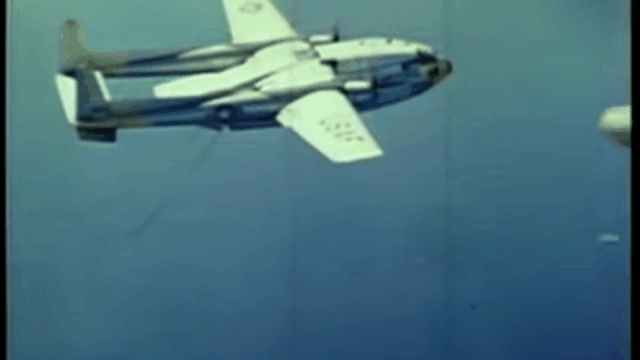a
The Corona program was the opening salvo in the effort to peer into Soviet-controlled territory from orbit. In order to recover the top-secret physical photographs it took, Air Force pilots took to the sky for what amounted to a claw arcade game, played miles above the Earth. Here’s a rare look at it in action.
As we reported last month, the first object ever recovered from space was a 136kg “bucket” of photographs that were jettisoned from an orbiting Corona satellite. In the early days of the program, it actually snagged these top secret packages from mid-air.
Here’s how it worked. As PetaPixel explains, the Corona satellites would shoot as much as 5000m of 70mm Kodak film, capturing footage of Soviet-controlled or influenced areas of the world (including much of the Middle East). When the film ran out, the footage would be jettisoned from the satellite and protected through reentry thanks to a so-called “film bucket” designed by GE. About 11 miles above the Earth, a parachute would deploy, and then it would be up to the eagle-eyed Air Force pilots to use a “claw” to snag the floating film pods before they reached Earth’s surface:
In this fantastic promo video from the early 1960s, we see pilots attempting (and failing at least once) to use the air claw to recover a drop. “Out of space it came, a man-made object commanded back to the Earth from which it was born,” says the narrator. “And ready, waiting, were men who plucked it from the air and treasure it carefully within the confines of their craft.”
“So man has learned to shoot matter beyond the boundaries of his world,” the video concludes poetically. “So man has learned to catch a falling star.”
It would be decades before digital film took over, so dozens of this mid-air “dead drops” were made over the course of the Cold War. Of course, they weren’t always successful — and the Air Force had backup protocols. If the buckets fell into the ocean, they could recover them there. And if they couldn’t, a “salt plug” would slowly dissolve over several days — preventing the film from falling into the wrong hands. Who knows how much Cold War surveillance footage eventually made it to the ocean floor? [PetaPixel; YouTube]
